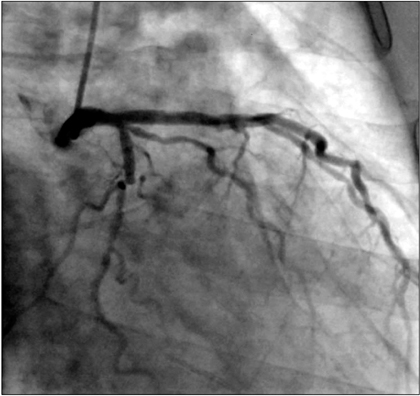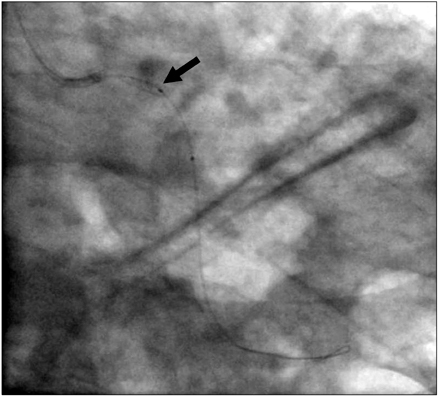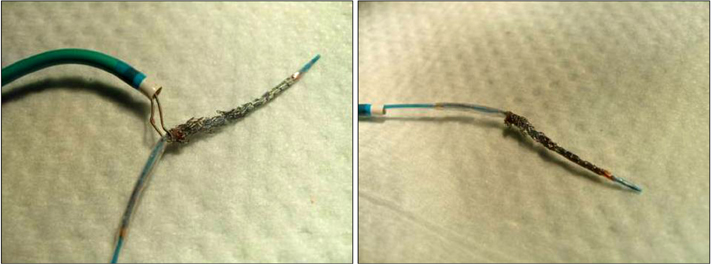Chonnam Med J.
2012 Aug;48(2):130-132. 10.4068/cmj.2012.48.2.130.
Retrieval of a Partially Degloved Stent Strut During Percutaneous Coronary Intervention
- Affiliations
-
- 1Department of Internal Medicine, Korea University Ansan Hospital, Ansan, Korea. vnlover@hanmail.net
- KMID: 2172216
- DOI: http://doi.org/10.4068/cmj.2012.48.2.130
Abstract
- Although stent entrapment is a rare event during percutaneous coronary intervention, stent entrapment can cause stent breakage or loss, which results in fatal complications such as stent embolism or acute myocardial infarction. We report one case of stent entrapment that was successfully treated by a snare via a contralateral transfemoral approach.
Keyword
MeSH Terms
Figure
Reference
-
1. Elsner M, Peifer A, Kasper W. Intracoronary loss of balloon-mounted stents: successful retrieval with a 2 mm-"Microsnare"-device. Cathet Cardiovasc Diagn. 1996. 39:271–276.
Article2. Carrozza JP Jr, Kuntz RE, Levine MJ, Pomerantz RM, Fishman RF, Mansour M, et al. Angiographic and clinical outcome of intracoronary stenting: immediate and long-term results from a large single-center experience. J Am Coll Cardiol. 1992. 20:328–337.
Article3. Schatz RA, Baim DS, Leon M, Ellis SG, Goldberg S, Hirshfeld JW, et al. Clinical experience with the Palmaz-Schatz coronary stent. Initial results of a multicenter study. Circulation. 1991. 83:148–161.
Article4. Schömig A, Kastrati A, Mudra H, Blasini R, Schühlen H, Klauss V, et al. Four-year experience with Palmaz-Schatz stenting in coronary angioplasty complicated by dissection with threatened or present vessel closure. Circulation. 1994. 90:2716–2724.
Article5. Feldman T. Tricks for overcoming difficult stent delivery. Catheter Cardiovasc Interv. 1999. 48:285–286.
Article6. Eggebrecht H, Haude M, von Birgelen C, Oldenburg O, Baumgart D, Herrmann J, et al. Nonsurgical retrieval of embolized coronary stents. Catheter Cardiovasc Interv. 2000. 51:432–440.
Article7. Foster-Smith KW, Garratt KN, Higano ST, Holmes DR Jr. Retrieval techniques for managing flexible intracoronary stent misplacement. Cathet Cardiovasc Diagn. 1993. 30:63–68.
Article8. Eeckhout E, Stauffer JC, Goy JJ. Retrieval of a migrated coronary stent by means of an alligator forceps catheter. Cathet Cardiovasc Diagn. 1993. 30:166–168.
Article9. Kim MH, Cha KS, Kim JS. Retrieval of dislodged and disfigured transradially delivered coronary stent: report on a case using forcep and antegrade brachial sheath insertion. Catheter Cardiovasc Interv. 2001. 52:489–491.
Article10. Berder V, Bedossa M, Gras D, Paillard F, Le Breton H, Pony JC. Retrieval of a lost coronary stent from the descending aorta using a PTCA balloon and biopsy forceps. Cathet Cardiovasc Diagn. 1993. 28:351–353.
Article
- Full Text Links
- Actions
-
Cited
- CITED
-
- Close
- Share
- Similar articles
-
- Extraction of a Fully Deployed Coronary Stent during Retrieval of Another Dislodged Stent
- Successful Retrieval of Intravascular Stent Remnants With a Combination of Rotational Atherectomy and a Gooseneck Snare
- Retrieval of a dislodged and dismounted coronary stent; using a rendezvous and snare technique at the brachial artery level via femoral approach
- Successful coronary stent retrieval from the ascending aorta using a gooseneck snare kit
- Re-mobilization of Lost Coronary Stent From the Axillary Artery to the Femoral Artery




